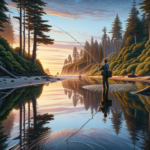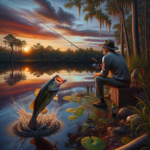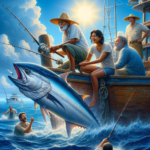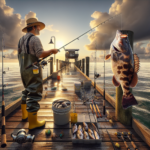Trolling for Snapper in the Gulf of Mexico
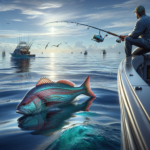
Introduction
Did you know that the Gulf of Mexico is home to some of the most sought-after snapper species in the world? Whether you’re a seasoned angler or a novice looking to try your hand at trolling, the Gulf offers a unique and rewarding fishing experience. This article will delve into the intricacies of trolling for snapper in the Gulf of Mexico, covering everything from the best techniques and gear to the top fishing spots and seasonal considerations.
Understanding the nuances of trolling for snapper is crucial for anyone looking to maximize their catch and enjoy a successful fishing trip. This guide aims to provide comprehensive insights into the subject, making it easier for you to plan your next fishing adventure.
Background/Context
Historical or Cultural Significance
Snapper fishing in the Gulf of Mexico has a rich history, deeply rooted in the local culture. For generations, communities along the Gulf Coast have relied on snapper as a vital food source and economic staple. The region’s fishing traditions have been passed down through families, making it a cherished activity that connects people to their heritage.
Geographical Overview
The Gulf of Mexico is a vast body of water bordered by the United States, Mexico, and Cuba. It boasts a diverse ecosystem, characterized by warm waters, coral reefs, and abundant marine life. The Gulf’s unique topography, including its continental shelf and numerous underwater structures, makes it an ideal habitat for various snapper species.
Key Points/Details
Fishing Techniques
Technique Overview
Trolling is a popular fishing technique that involves dragging baited lines or lures behind a moving boat. This method is particularly effective for targeting snapper, as it allows anglers to cover a large area and locate schools of fish. Key trolling techniques include using downriggers, planer boards, and outriggers to control the depth and spread of the lines.
When and Where to Use
Trolling for snapper is most effective in areas with underwater structures such as reefs, wrecks, and ledges. These structures provide shelter and feeding grounds for snapper. The best times to troll are during the early morning and late afternoon when snapper are most active. Seasonal variations also play a role, with summer and early fall being prime times for snapper fishing in the Gulf.
Recommended Gear
- Rods and Reels: Medium to heavy-action rods paired with high-capacity reels are ideal for trolling.
- Lines: Braided lines with a high test strength are recommended for their durability and sensitivity.
- Bait and Lures: Live bait such as pilchards, squid, and cigar minnows are highly effective. Artificial lures like jigs and soft plastics can also be used.
- Downriggers and Planer Boards: Essential for controlling the depth and spread of your lines.
Species Information
Species Overview
The Gulf of Mexico is home to several snapper species, including the Red Snapper, Lane Snapper, and Mangrove Snapper. Red Snapper is the most prized among anglers due to its size and fighting ability. These fish are typically found near reefs and structures at depths ranging from 30 to 200 feet.
Best Practices
To successfully catch snapper, it’s essential to use the right bait and techniques. Live bait is often more effective than artificial lures. When trolling, maintain a steady speed and vary the depth of your lines to locate schools of snapper. Pay attention to your fish finder to identify underwater structures and fish activity.
Location Information
Top Fishing Spots
- Destin, Florida: Known as the “World’s Luckiest Fishing Village,” Destin offers excellent snapper fishing opportunities.
- Venice, Louisiana: This area is famous for its offshore fishing and abundant snapper populations.
- Galveston, Texas: Galveston provides easy access to productive snapper fishing grounds in the Gulf.
Regulations and Licenses
Fishing regulations in the Gulf of Mexico are strictly enforced to ensure sustainable fish populations. Anglers must obtain a valid fishing license and adhere to catch limits and seasonal restrictions. It’s essential to check the latest regulations from local authorities before heading out.
Seasonal Considerations
Seasonal Variations
Fishing conditions in the Gulf of Mexico change throughout the year. Summer and early fall are the best times for snapper fishing, as water temperatures are optimal, and fish are more active. Winter and spring can also be productive, but anglers may need to adjust their techniques and target deeper waters.
Best Times to Fish
The early morning and late afternoon are the most productive times for trolling for snapper. During these periods, snapper are more likely to be feeding and less wary of bait. Additionally, fishing during tidal changes can increase your chances of success.
Events and Tournaments
Event Overview
The Gulf of Mexico hosts several fishing tournaments throughout the year, attracting anglers from all over the world. Notable events include the Destin Fishing Rodeo, the Alabama Deep Sea Fishing Rodeo, and the Texas International Fishing Tournament. These events offer opportunities to compete for prizes and showcase your fishing skills.
Preparation Tips
To prepare for a fishing tournament, ensure your gear is in top condition and practice your trolling techniques. Familiarize yourself with the tournament rules and regulations, and plan your strategy based on the fishing conditions and target species. Pre-fishing the tournament area can also give you a competitive edge.
Tips and Best Practices
General Tips
- Always use fresh bait to increase your chances of attracting snapper.
- Maintain a consistent trolling speed, typically between 2 to 4 knots.
- Use a fish finder to locate underwater structures and schools of fish.
- Vary the depth of your lines to cover different water columns.
Avoid Common Mistakes
- Overlooking Regulations: Always check and follow local fishing regulations to avoid fines and contribute to conservation efforts.
- Using the Wrong Gear: Ensure your gear is suitable for trolling and can handle the size and strength of snapper.
- Ignoring Weather Conditions: Pay attention to weather forecasts and avoid fishing in rough or unsafe conditions.
Advanced Techniques
- Using Downriggers: Downriggers allow you to control the depth of your bait precisely, increasing your chances of reaching snapper at different depths.
- Employing Planer Boards: Planer boards help spread your lines and cover a wider area, making it easier to locate schools of snapper.
- Chumming: Chumming involves dispersing small pieces of bait in the water to attract snapper to your trolling area.
Gear and Equipment Recommendations
Essential Gear
- Medium to heavy-action trolling rods
- High-capacity reels with braided lines
- Live bait such as pilchards, squid, and cigar minnows
- Downriggers and planer boards
- Fish finder
Optional Gear/Upgrades
- Electric reels for deep-water trolling
- High-quality rod holders
- Advanced GPS and navigation systems
- Chum dispensers
Where to Buy or Rent
Local tackle shops in Gulf Coast cities such as Destin, Venice, and Galveston offer a wide range of fishing gear and equipment. Online retailers like Bass Pro Shops, Cabela’s, and Amazon also provide extensive selections. Some charter services may offer gear rentals for those who prefer not to invest in their own equipment.
Safety and Conservation
Safety Tips
- Always wear a life jacket when on the water.
- Check weather forecasts before heading out and avoid fishing in rough conditions.
- Inform someone of your fishing plans and expected return time.
- Carry a first aid kit and emergency supplies on your boat.
Conservation Practices
- Practice catch and release to help maintain snapper populations.
- Follow local fishing regulations and catch limits.
- Avoid damaging coral reefs and underwater structures.
- Dispose of fishing line and other waste properly to protect marine life.
Planning Your Trip
Accommodations
There are numerous accommodation options near popular fishing spots in the Gulf of Mexico. From beachfront hotels and resorts to vacation rentals and campgrounds, you’ll find a variety of choices to suit your preferences and budget. Destin, Venice, and Galveston all offer excellent lodging options for anglers.
Travel Tips
- Plan your route in advance and check for any road closures or construction.
- Consider renting a boat if you don’t have your own, as many local marinas offer rentals.
- Pack essential items such as sunscreen, hats, and plenty of water to stay hydrated.
Additional Activities
If you’re traveling with family or friends who aren’t as enthusiastic about fishing, there are plenty of other activities to enjoy in the Gulf Coast region. From beachcombing and swimming to exploring local attractions and dining at seafood restaurants, there’s something for everyone to enjoy.
Frequently Asked Questions (FAQs)
What is the best time of year to troll for snapper in the Gulf of Mexico?
The best time to troll for snapper in the Gulf of Mexico is during the summer and early fall when water temperatures are optimal, and fish are more active.
Do I need a fishing license to troll for snapper in the Gulf of Mexico?
Yes, a valid fishing license is required to fish in the Gulf of Mexico. Be sure to check local regulations for specific requirements and obtain the necessary permits.
What type of bait is most effective for trolling for snapper?
Live bait such as pilchards, squid, and cigar minnows are highly effective for trolling for snapper. Artificial lures like jigs and soft plastics can also be used.
Are there any specific regulations for snapper fishing in the Gulf of Mexico?
Yes, there are specific regulations for snapper fishing in the Gulf of Mexico, including catch limits, size restrictions, and seasonal closures. Always check the latest regulations from local authorities before heading out.
Conclusion
Trolling for snapper in the Gulf of Mexico offers an exciting and rewarding fishing experience. By understanding the best techniques, gear, and locations, you can maximize your chances of a successful catch. Remember to follow local regulations, practice conservation, and prioritize safety to ensure a sustainable and enjoyable fishing adventure. Whether you’re a seasoned angler or a novice, the Gulf of Mexico’s abundant snapper populations and diverse fishing opportunities make it a must-visit destination for any fishing enthusiast.

